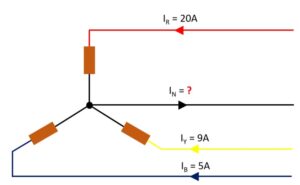The Neutral Current Calculator is a tool for calculating the unbalanced current in a three phase system. The formula for calculating the neutral current in a three-phase system depends on various factors, including the type of load and whether the system is balanced or unbalanced.
What is the Balanced Three-Phase System?
In a balanced three-phase system, where the loads on all three phases are equal and have the same power factor, the neutral current is typically zero. This is because the phasor sum of the three phase currents cancels out in such a way that no current flows in the neutral conductor.
Mathematically, for a balanced system with three phase currents (Ia, Ib, and Ic), the neutral current (In) can be calculated as:
In = 0

What is the Unbalanced Three-Phase System?
In an unbalanced three-phase system, where the loads on the phases are unequal or have different power factors, there can be a non-zero neutral current. To calculate the neutral current in this case, you would need to know the individual phase currents and their angles with respect to the reference.
Mathematically, for an unbalanced system with phase currents (Ia, Ib, and Ic), the neutral current (In) can be calculated as:
In = √(Ir^2 + Iy^2 + Ib^2 – Ir * Iy – Iy * Ib – Ib * Ir)
In this formula, Ia, Ib, and Ic are the magnitudes of the phase currents.
It’s important to note that calculating the neutral current in an unbalanced system can be more complex due to the varying load conditions. In practical applications, software or specialized tools are often used to perform these calculations.
Read: Net Force Calculator